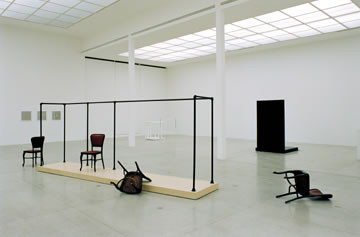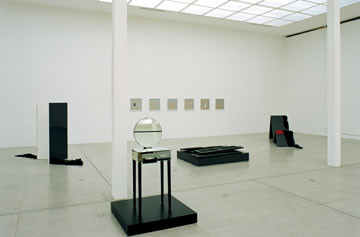Tom Burr
28 Apr - 24 Jun 2007
TOM BURR
MOODS
April 28 – June 24, 2007
“Moods”, be they specific or vague, depend on various factors that may be individual just as they may reflect a particular time or generation, as described by Amanda Lear in a line from her song Alphabet “this is my alphabet for the children of my generation, ... each generation may find a different mood to their world...”. Tom Burr’s elegant arrangements of sculptures and objects aim for romantic desire at the same time as being cerebral events. At the Secession, Burr is showing new and recent works, loosely grouped and dividing the space into several areas.
At the center stands a group of stage- or cage-like objects situated somewhere between sculpture, runway, boutique decor, and set design. They recall the sculptural spaces of Alberto Giacometti and Cady Noland, or Pierre Klossowski’s Barres Paralleles. The pedestals are integral parts of these sculptures, which are not site-specific and which could be installed anywhere. Burr plays with the idea of an artist producing an autonomous artwork in his studio. Other sculptures, screens, and horizontal foldable objects that seem to refer to the human figure, also appear to be transportable and adaptable to any given situation. They are constructions of subjectivity, display, and instability (of identity, objects, and spaces). The installations include a number of objects such as items of clothing, mirrors, chairs,
Tom Burr’s works act out past discourses on sculpture—from site-specificity and contextuality through theatricality—in different variants. In this way, the question of the author can again be asked without wishing to return to the figure of the artist as a director genius. Instead, it deals with the uncertain foundations of identity and unstable subjectivity. A number of characters are invoked, from the painter James Abbott McNeill Whistler (to whom the titles Arrangement in Black and Blue and Arrangement in Black and Red refer, and whose mention in turn invokes John Singer Sargent and Oscar Wilde), Jean Cocteau, and Truman Capote through Jack Kerouac, who is the subject of a series of collages.
Nestling in the folds of a suit by the Austrian designer Helmut Lang worn by the artist in the mid 1990’s, we also find Jean Cocteau’s book Thomas the Impostor, creating the effect or suggestion of an autobiographical reference, at the same time as eluding this possibility. In the form of Jack Pierson, Burr creates an alter ego by referring back to a joint show by the two artists at Galerie Neu in Berlin in 2006, a reference complicated by the introduction of a further “Jack,” namely Jack Kerouac. The territory of literary and popular references is charted, but so is the collapse of the resulting figure “Jack” under the weight of references that do not stand the test of scrutiny. In the collages, the portrayal of Jack Kerouac already becomes a farce, an act of self-mockery.
The fictitious nature of the author is also apparent in the Vanities: an objet trouvé, a make-up table with faded mirrors, and two perspex constructions situated somewhere between literal interpretation of this piece of furniture and total abstraction. Playing on the multiple meanings of the word, the perspex vanities recall a real make-up table in a Vienna hotel room, a nostalgic room suited to writing letters, maybe at this table, where the lonely writer encounters himself in the mirror as a stranger. The Proustian atmosphere of the room, used beforehand and afterwards by someone else, reminds the guest that his identity in this place is a borrowed one, as it can be cast off again, like a suit.
TOM BURR, born 1963, lives and works in New York.
SOLO SHOWS (selection): 2006 Galerie Neu, Berlin (together with Jack Pierson); Extrospective, Museé Cantonal des Beaux-Arts de Lausanne, Lausanne; Relapse, Stuart Shave/ Modern Art, London; 2005 Complete Breakdown, Galerie Neu, Berlin; Privy, Please, The Norfolk Library, Norfolk (Connecticut); The Complete Stories of Truman Capote, romaromaroma, Rome; 2004 Our Lady of the Flowers, Galleria Franco Noero, Turin; 2003 Die Ställe, Galerie Christian Nagel, Cologne; The Screens, Institute for Visual Culture, Cambridge; 2002 Piscine, Galerie Almine Reich, Paris; Deep Purple, Whitney Museum of American Art, New York; Dog Days, Greene Naftali Gallery, New York; 2001 Brutalism, Galerie Neu, Berlin.
GROUP SHOWS (selection): 2006 The Eighth Square, Museum Ludwig, Cologne; The Name of This Show Is Not GAY ART NOW, Paul Kasmin Gallery, New York, curated by Jack Pierson; Warum etwas zeigen, was man sehen kann, Galerie für Zeitgenössische Kunst, Leipzig; 2005 HaubrokShows, B Sharp, Berlin; Nolens Volens, Galerie Neu, Berlin; Residence, MICA Foundation, New York; 2004 When the lights go out..., Cohan & Leslie, New York; The Future Has a Silver Lining, Migros Museum für Gegenwartskunst, Zurich; Whitney Biennial 2004, Whitney Museum of American Art, New York; Beginning Here: 101 Ways, Visual Arts Gallery, New York; 2003 Le Rayon Noir, Circuit-Association d’Art Contemporain, Lausanne; 2002 Grey Gardens, Michael Kohn Gallery, Los Angeles; My head is on fire but my heart is full of love, Charlottenborg Udstillings-bygning, Copenhagen; 2001 Deliberate Living, Greene Naftali Gallery, New York.
MOODS
April 28 – June 24, 2007
“Moods”, be they specific or vague, depend on various factors that may be individual just as they may reflect a particular time or generation, as described by Amanda Lear in a line from her song Alphabet “this is my alphabet for the children of my generation, ... each generation may find a different mood to their world...”. Tom Burr’s elegant arrangements of sculptures and objects aim for romantic desire at the same time as being cerebral events. At the Secession, Burr is showing new and recent works, loosely grouped and dividing the space into several areas.
At the center stands a group of stage- or cage-like objects situated somewhere between sculpture, runway, boutique decor, and set design. They recall the sculptural spaces of Alberto Giacometti and Cady Noland, or Pierre Klossowski’s Barres Paralleles. The pedestals are integral parts of these sculptures, which are not site-specific and which could be installed anywhere. Burr plays with the idea of an artist producing an autonomous artwork in his studio. Other sculptures, screens, and horizontal foldable objects that seem to refer to the human figure, also appear to be transportable and adaptable to any given situation. They are constructions of subjectivity, display, and instability (of identity, objects, and spaces). The installations include a number of objects such as items of clothing, mirrors, chairs,
Tom Burr’s works act out past discourses on sculpture—from site-specificity and contextuality through theatricality—in different variants. In this way, the question of the author can again be asked without wishing to return to the figure of the artist as a director genius. Instead, it deals with the uncertain foundations of identity and unstable subjectivity. A number of characters are invoked, from the painter James Abbott McNeill Whistler (to whom the titles Arrangement in Black and Blue and Arrangement in Black and Red refer, and whose mention in turn invokes John Singer Sargent and Oscar Wilde), Jean Cocteau, and Truman Capote through Jack Kerouac, who is the subject of a series of collages.
Nestling in the folds of a suit by the Austrian designer Helmut Lang worn by the artist in the mid 1990’s, we also find Jean Cocteau’s book Thomas the Impostor, creating the effect or suggestion of an autobiographical reference, at the same time as eluding this possibility. In the form of Jack Pierson, Burr creates an alter ego by referring back to a joint show by the two artists at Galerie Neu in Berlin in 2006, a reference complicated by the introduction of a further “Jack,” namely Jack Kerouac. The territory of literary and popular references is charted, but so is the collapse of the resulting figure “Jack” under the weight of references that do not stand the test of scrutiny. In the collages, the portrayal of Jack Kerouac already becomes a farce, an act of self-mockery.
The fictitious nature of the author is also apparent in the Vanities: an objet trouvé, a make-up table with faded mirrors, and two perspex constructions situated somewhere between literal interpretation of this piece of furniture and total abstraction. Playing on the multiple meanings of the word, the perspex vanities recall a real make-up table in a Vienna hotel room, a nostalgic room suited to writing letters, maybe at this table, where the lonely writer encounters himself in the mirror as a stranger. The Proustian atmosphere of the room, used beforehand and afterwards by someone else, reminds the guest that his identity in this place is a borrowed one, as it can be cast off again, like a suit.
TOM BURR, born 1963, lives and works in New York.
SOLO SHOWS (selection): 2006 Galerie Neu, Berlin (together with Jack Pierson); Extrospective, Museé Cantonal des Beaux-Arts de Lausanne, Lausanne; Relapse, Stuart Shave/ Modern Art, London; 2005 Complete Breakdown, Galerie Neu, Berlin; Privy, Please, The Norfolk Library, Norfolk (Connecticut); The Complete Stories of Truman Capote, romaromaroma, Rome; 2004 Our Lady of the Flowers, Galleria Franco Noero, Turin; 2003 Die Ställe, Galerie Christian Nagel, Cologne; The Screens, Institute for Visual Culture, Cambridge; 2002 Piscine, Galerie Almine Reich, Paris; Deep Purple, Whitney Museum of American Art, New York; Dog Days, Greene Naftali Gallery, New York; 2001 Brutalism, Galerie Neu, Berlin.
GROUP SHOWS (selection): 2006 The Eighth Square, Museum Ludwig, Cologne; The Name of This Show Is Not GAY ART NOW, Paul Kasmin Gallery, New York, curated by Jack Pierson; Warum etwas zeigen, was man sehen kann, Galerie für Zeitgenössische Kunst, Leipzig; 2005 HaubrokShows, B Sharp, Berlin; Nolens Volens, Galerie Neu, Berlin; Residence, MICA Foundation, New York; 2004 When the lights go out..., Cohan & Leslie, New York; The Future Has a Silver Lining, Migros Museum für Gegenwartskunst, Zurich; Whitney Biennial 2004, Whitney Museum of American Art, New York; Beginning Here: 101 Ways, Visual Arts Gallery, New York; 2003 Le Rayon Noir, Circuit-Association d’Art Contemporain, Lausanne; 2002 Grey Gardens, Michael Kohn Gallery, Los Angeles; My head is on fire but my heart is full of love, Charlottenborg Udstillings-bygning, Copenhagen; 2001 Deliberate Living, Greene Naftali Gallery, New York.



